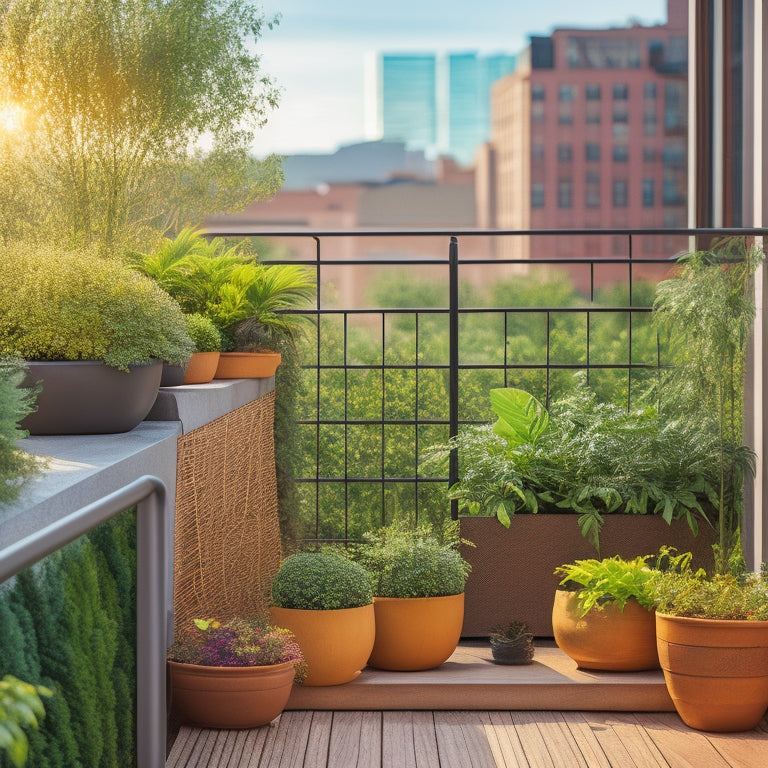
3 Best Ways to Grow a Vertical Balcony Garden
Share
You can create a thriving vertical balcony garden by focusing on three key areas: choosing the right plants, building a sturdy structure, and providing ongoing care and maintenance. Select plants that thrive in vertical conditions, considering sunlight requirements, growth rates, and moisture needs. Design a structure that accommodates mature plant size, growth habits, and sunlight exposure, using durable materials that support soil and water weight. Finally, implement effective watering, fertilization, and pruning techniques, and adjust care routines seasonally to guarantee peak growth - and with these fundamentals in place, you'll be well on your way to a lush, vibrant garden that flourishes.
Key Takeaways
• Select plants suited for vertical conditions and research their sunlight requirements for optimal growth.
• Design a structure that accommodates mature plant size, growth habits, and sunlight exposure, using durable materials.
• Implement effective watering techniques, like misting or dripping, and establish a fertilization schedule tailored to plant needs.
• Prioritize pruning for healthy growth, air circulation, and pest prevention, and employ integrated pest management strategies.
• Adjust care routines seasonally, reducing watering and fertilization during dormancy to ensure a thriving vertical balcony garden.
Choosing the Right Plants
Selecting plants that thrive in vertical conditions is crucial to the success of your balcony garden, as they must tolerate reduced soil volume, higher temperatures, and intense sunlight. You'll need to take into account plants that can adapt to these unique conditions. Research the sunlight requirements of each plant to make sure you're providing the ideal amount of light. Some plants require full sun, while others prefer partial shade. Make a list of plants that fit your balcony's sunlight conditions.
When choosing plants, reflect on their compatibility with one another. Mixing plants with different growth rates, moisture requirements, or pruning needs can lead to maintenance headaches. Opt for plants with similar requirements to create a harmonious and thriving environment. For instance, pair flowering plants like petunias or geraniums with leafy greens like lettuce or kale for a visually appealing combination.
Building and Installing Structure
With your plant selection complete, you're ready to design and build a structure that will support your vertical balcony garden, taking into account the weight and moisture requirements of your chosen plants.
Consider the mature size of your plants, their growth habits, and the amount of sunlight they'll receive. These factors will influence your design considerations, such as the spacing between rows, the depth of the planters, and the overall structure's height and width.
When selecting materials, prioritize durability, water resistance, and weight capacity. You'll want to choose a material that can withstand the elements and support the weight of the soil, plants, and water.
Trellises, arbors, or wall-mounted planters made from rust-resistant metals, decay-resistant woods, or high-quality plastics are excellent options. Ascertain the structure is sturdy and securely attached to the balcony railing or wall to prevent it from toppling over.
Additionally, consider incorporating a built-in irrigation system or a self-watering mechanism to make maintenance easier.
Ongoing Care and Maintenance
As you tend to your thriving vertical balcony garden, regular watering, fertilization, and pruning become essential to maintaining its health and beauty.
You'll need to adopt effective watering techniques, such as misting or dripping, to guarantee plants receive the right amount of moisture.
Fertilization schedules should be tailored to your plants' specific needs, with balanced fertilizers applied every 1-2 weeks during the growing season.
Pruning is vital for promoting healthy growth, encouraging air circulation, and preventing pest infestations.
Speaking of pests, you'll need to stay vigilant and implement integrated pest management strategies, such as introducing beneficial insects or using organic pesticides, to prevent infestations.
As the seasons change, make seasonal adjustments to your care routine, such as reducing watering and fertilization during the dormant period.
Frequently Asked Questions
How Much Weight Can a Vertical Balcony Garden Typically Hold?
When planning your vertical garden, you'll need to take into account weight limits, ensuring your balcony's structural considerations can support the combined weight of soil, plants, and materials, typically ranging from 10-50 pounds per square foot, depending on the system's design.
Can I Use a Trellis to Support Climbing Plants in My Garden?
You can use a trellis to support climbing plants, choosing from types like obelisk, fan-shaped, or wall-mounted trellises, which provide sturdy frameworks for plants like ivy, clematis, or morning glories to ascend and thrive.
Are Vertical Gardens Suitable for Apartments With Full Sun Exposure?
"In ancient Babylon's hanging gardens, sun-kissed flora thrived. Similarly, you'll find vertical gardens perfect for apartments receiving full sun exposure, as they allow for precise control over soil, water, and pruning for sun-loving plants, making apartment gardening a breeze."
Can I Grow a Vertical Garden on a Balcony With High Winds?
You'll need to choose wind-resistant plants and a sturdy balcony garden design to combat high winds, ensuring your vertical garden remains secure and thriving, even in gusty conditions.
Do Vertical Gardens Require More Water Than Traditional Gardens?
You'll find that vertical gardens often require more precise irrigation techniques, which can actually lead to better water conservation, as you're delivering water directly to the roots, reducing evaporation and runoff, and optimizing water usage.
Related Posts
-

How Much Do Concrete Planters Weigh
When creating a concrete planter, you'll need to take into account the weight implications of your design. The type a...
-

How Much Do Concrete Planters Weigh
When creating a concrete planter, you'll need to take into account the weight implications of your design. The type a...
-

How Much Do Concrete Planters Weigh
When creating a concrete planter, you'll need to take into account the weight implications of your design. The type a...
-

How Much Do Concrete Planters Weigh
When creating a concrete planter, you'll need to take into account the weight implications of your design. The type a...
-

How Much Do Concrete Planters Weigh
When creating a concrete planter, you'll need to take into account the weight implications of your design. The type a...
-

How Much Do Concrete Planters Weigh
When creating a concrete planter, you'll need to take into account the weight implications of your design. The type a...
-

How Much Do Concrete Planters Weigh
When creating a concrete planter, you'll need to take into account the weight implications of your design. The type a...
-

How Much Do Concrete Planters Weigh
When creating a concrete planter, you'll need to take into account the weight implications of your design. The type a...
-

How Much Do Concrete Planters Weigh
When creating a concrete planter, you'll need to take into account the weight implications of your design. The type a...
-

How Much Do Concrete Planters Weigh
When creating a concrete planter, you'll need to take into account the weight implications of your design. The type a...
-

How Much Do Concrete Planters Weigh
When creating a concrete planter, you'll need to take into account the weight implications of your design. The type a...
-

How Much Do Concrete Planters Weigh
When creating a concrete planter, you'll need to take into account the weight implications of your design. The type a...
-

How Much Do Concrete Planters Weigh
When creating a concrete planter, you'll need to take into account the weight implications of your design. The type a...
-

How Much Do Concrete Planters Weigh
When creating a concrete planter, you'll need to take into account the weight implications of your design. The type a...
-

How Much Do Concrete Planters Weigh
When creating a concrete planter, you'll need to take into account the weight implications of your design. The type a...
-

How Much Do Concrete Planters Weigh
When creating a concrete planter, you'll need to take into account the weight implications of your design. The type a...
-

How Much Do Concrete Planters Weigh
When creating a concrete planter, you'll need to take into account the weight implications of your design. The type a...
-

How Much Do Concrete Planters Weigh
When creating a concrete planter, you'll need to take into account the weight implications of your design. The type a...
-

How Much Do Concrete Planters Weigh
When creating a concrete planter, you'll need to take into account the weight implications of your design. The type a...
-

How Much Do Concrete Planters Weigh
When creating a concrete planter, you'll need to take into account the weight implications of your design. The type a...
-

How Much Do Concrete Planters Weigh
When creating a concrete planter, you'll need to take into account the weight implications of your design. The type a...
-

How Much Do Concrete Planters Weigh
When creating a concrete planter, you'll need to take into account the weight implications of your design. The type a...
-

How Much Do Concrete Planters Weigh
When creating a concrete planter, you'll need to take into account the weight implications of your design. The type a...
-

How Much Do Concrete Planters Weigh
When creating a concrete planter, you'll need to take into account the weight implications of your design. The type a...
-

How Much Do Concrete Planters Weigh
When creating a concrete planter, you'll need to take into account the weight implications of your design. The type a...
-

How Much Do Concrete Planters Weigh
When creating a concrete planter, you'll need to take into account the weight implications of your design. The type a...
-

How Much Do Concrete Planters Weigh
When creating a concrete planter, you'll need to take into account the weight implications of your design. The type a...
-

How Much Do Concrete Planters Weigh
When creating a concrete planter, you'll need to take into account the weight implications of your design. The type a...
-

How Much Do Concrete Planters Weigh
When creating a concrete planter, you'll need to take into account the weight implications of your design. The type a...
-

What to Seal Your Planters With for Longevity
When sealing your planters for longevity, it's vital to choose a sealant compatible with your planter material - whet...
-

What to Seal Your Planters With for Longevity
When sealing your planters for longevity, it's vital to choose a sealant compatible with your planter material - whet...
-

What to Seal Your Planters With for Longevity
When sealing your planters for longevity, it's vital to choose a sealant compatible with your planter material - whet...
-

What to Seal Your Planters With for Longevity
When sealing your planters for longevity, it's vital to choose a sealant compatible with your planter material - whet...
-

What to Seal Your Planters With for Longevity
When sealing your planters for longevity, it's vital to choose a sealant compatible with your planter material - whet...
-

What to Seal Your Planters With for Longevity
When sealing your planters for longevity, it's vital to choose a sealant compatible with your planter material - whet...
-

What to Seal Your Planters With for Longevity
When sealing your planters for longevity, it's vital to choose a sealant compatible with your planter material - whet...
-

What to Seal Your Planters With for Longevity
When sealing your planters for longevity, it's vital to choose a sealant compatible with your planter material - whet...
-

What to Seal Your Planters With for Longevity
When sealing your planters for longevity, it's vital to choose a sealant compatible with your planter material - whet...
-

What to Seal Your Planters With for Longevity
When sealing your planters for longevity, it's vital to choose a sealant compatible with your planter material - whet...
-

What to Seal Your Planters With for Longevity
When sealing your planters for longevity, it's vital to choose a sealant compatible with your planter material - whet...
-

What to Seal Your Planters With for Longevity
When sealing your planters for longevity, it's vital to choose a sealant compatible with your planter material - whet...
-

What to Seal Your Planters With for Longevity
When sealing your planters for longevity, it's vital to choose a sealant compatible with your planter material - whet...
-

What to Seal Your Planters With for Longevity
When sealing your planters for longevity, it's vital to choose a sealant compatible with your planter material - whet...
-

What to Seal Your Planters With for Longevity
When sealing your planters for longevity, it's vital to choose a sealant compatible with your planter material - whet...
-

What to Seal Your Planters With for Longevity
When sealing your planters for longevity, it's vital to choose a sealant compatible with your planter material - whet...
-

What to Seal Your Planters With for Longevity
When sealing your planters for longevity, it's vital to choose a sealant compatible with your planter material - whet...
-

What to Seal Your Planters With for Longevity
When sealing your planters for longevity, it's vital to choose a sealant compatible with your planter material - whet...
-

What to Seal Your Planters With for Longevity
When sealing your planters for longevity, it's vital to choose a sealant compatible with your planter material - whet...
-

What to Seal Your Planters With for Longevity
When sealing your planters for longevity, it's vital to choose a sealant compatible with your planter material - whet...
-

What to Seal Your Planters With for Longevity
When sealing your planters for longevity, it's vital to choose a sealant compatible with your planter material - whet...
-

What to Seal Your Planters With for Longevity
When sealing your planters for longevity, it's vital to choose a sealant compatible with your planter material - whet...
-

What to Seal Your Planters With for Longevity
When sealing your planters for longevity, it's vital to choose a sealant compatible with your planter material - whet...
-

What to Seal Your Planters With for Longevity
When sealing your planters for longevity, it's vital to choose a sealant compatible with your planter material - whet...
-

What to Seal Your Planters With for Longevity
When sealing your planters for longevity, it's vital to choose a sealant compatible with your planter material - whet...
-

What to Seal Your Planters With for Longevity
When sealing your planters for longevity, it's vital to choose a sealant compatible with your planter material - whet...
-

What to Seal Your Planters With for Longevity
When sealing your planters for longevity, it's vital to choose a sealant compatible with your planter material - whet...
-

What to Seal Your Planters With for Longevity
When sealing your planters for longevity, it's vital to choose a sealant compatible with your planter material - whet...
-

What to Seal Your Planters With for Longevity
When sealing your planters for longevity, it's vital to choose a sealant compatible with your planter material - whet...
-

What to Seal Your Planters With for Longevity
When sealing your planters for longevity, it's vital to choose a sealant compatible with your planter material - whet...
-

What to Seal Your Planters With for Longevity
When sealing your planters for longevity, it's vital to choose a sealant compatible with your planter material - whet...
-

What to Seal Your Planters With for Longevity
When sealing your planters for longevity, it's vital to choose a sealant compatible with your planter material - whet...
-

Must-Have Tools for Building Block Planters Online
When building block planters online, you'll need essential tools to guarantee a sturdy and visually appealing structu...
-

Must-Have Tools for Building Block Planters Online
When building block planters online, you'll need essential tools to guarantee a sturdy and visually appealing structu...
-

Must-Have Tools for Building Block Planters Online
When building block planters online, you'll need essential tools to guarantee a sturdy and visually appealing structu...
-

Must-Have Tools for Building Block Planters Online
When building block planters online, you'll need essential tools to guarantee a sturdy and visually appealing structu...
-

Must-Have Tools for Building Block Planters Online
When building block planters online, you'll need essential tools to guarantee a sturdy and visually appealing structu...
-

Must-Have Tools for Building Block Planters Online
When building block planters online, you'll need essential tools to guarantee a sturdy and visually appealing structu...
-

Must-Have Tools for Building Block Planters Online
When building block planters online, you'll need essential tools to guarantee a sturdy and visually appealing structu...
-

Must-Have Tools for Building Block Planters Online
When building block planters online, you'll need essential tools to guarantee a sturdy and visually appealing structu...
-

Must-Have Tools for Building Block Planters Online
When building block planters online, you'll need essential tools to guarantee a sturdy and visually appealing structu...
-

Must-Have Tools for Building Block Planters Online
When building block planters online, you'll need essential tools to guarantee a sturdy and visually appealing structu...
-

Must-Have Tools for Building Block Planters Online
When building block planters online, you'll need essential tools to guarantee a sturdy and visually appealing structu...
-

Must-Have Tools for Building Block Planters Online
When building block planters online, you'll need essential tools to guarantee a sturdy and visually appealing structu...
-

Must-Have Tools for Building Block Planters Online
When building block planters online, you'll need essential tools to guarantee a sturdy and visually appealing structu...
-

Must-Have Tools for Building Block Planters Online
When building block planters online, you'll need essential tools to guarantee a sturdy and visually appealing structu...
-

Must-Have Tools for Building Block Planters Online
When building block planters online, you'll need essential tools to guarantee a sturdy and visually appealing structu...
-

Must-Have Tools for Building Block Planters Online
When building block planters online, you'll need essential tools to guarantee a sturdy and visually appealing structu...
-

Must-Have Tools for Building Block Planters Online
When building block planters online, you'll need essential tools to guarantee a sturdy and visually appealing structu...
-

Must-Have Tools for Building Block Planters Online
When building block planters online, you'll need essential tools to guarantee a sturdy and visually appealing structu...
-

Must-Have Tools for Building Block Planters Online
When building block planters online, you'll need essential tools to guarantee a sturdy and visually appealing structu...
-

Must-Have Tools for Building Block Planters Online
When building block planters online, you'll need essential tools to guarantee a sturdy and visually appealing structu...
-

Must-Have Tools for Building Block Planters Online
When building block planters online, you'll need essential tools to guarantee a sturdy and visually appealing structu...
-

Must-Have Tools for Building Block Planters Online
When building block planters online, you'll need essential tools to guarantee a sturdy and visually appealing structu...
-

Must-Have Tools for Building Block Planters Online
When building block planters online, you'll need essential tools to guarantee a sturdy and visually appealing structu...


